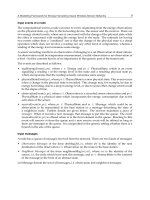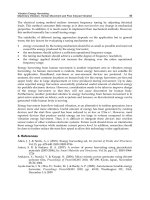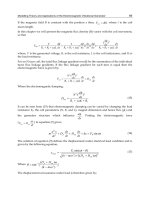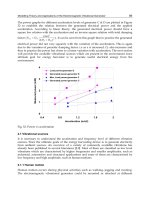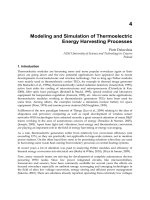cephalopods present and past
Bạn đang xem bản rút gọn của tài liệu. Xem và tải ngay bản đầy đủ của tài liệu tại đây (14.39 MB, 490 trang )
Cephalopods Present and Past:
New Insights and Fresh Perspectives
Cephalopods Present and Past:
New Insights and Fresh
Perspectives
Edited by
Neil H. Landman
Division of Paleontology (Invertebrates)
American Museum of Natural History
New York, NY, USA
Richard Arnold Davis
Department of Biology
College of Mount St. Joseph
Cincinnati, OH, USA
Royal H. Mapes
Department of Geological Sciences
Ohio University
Athens, OH, USA
A C.I.P. Catalogue record for this book is available from the Library of Congress.
ISBN 978-1-4020-6461-6
ISBN 978-1-4020-6806-5 (e-book)
Published by Springer,
P.O. Box 17, 3300 AA Dordrecht, The Netherlands.
www.springer.com
Cover illustration: Reconstruction of the life cycle of Manticoceras, depicting the orientations of the
aperture of four representative growth stages. Figure by Christian Klug, Universität Zürich.
Printed on acid-free paper
All Rights Reserved
© 2007 Springer
No part of this work may be reproduced, stored in a retrieval system, or transmitted in any form or by
any means, electronic, mechanical, photocopying, microfilming, recording or otherwise, without written
permission from the Publisher, with the exception of any material supplied specifically for the purpose
of being entered and executed on a computer system, for exclusive use by the purchaser of the work.
Preface
Cephalopods are diverse, highly developed molluscs capable of swimming and jet
propulsion. These animals are an important component of present-day marine ecosys-
tems throughout the world and comprise approximately 900 species. They also have
an extraordinary fossil record, extending back to the Cambrian Period, with as many
as 10,000 extinct species. Throughout their long history, they have experienced spec-
tacular radiations and near-total extinctions. Because of their superb fossil record,
they also serve as ideal index fossils to subdivide geologic time. This book touches
on many of these themes, and it treats both fossil and present-day cephalopods. The
chapters are outgrowths of presentations at the Sixth International Symposium
“Cephalopods – Present and Past,” at the University of Arkansas in Fayetteville,
September 16–19, 2004. The Symposium was organized principally by Walter L.
Manger of the Department of Geology, University of Arkansas. The editors gratefully
acknowledge Walter for his terrific job in putting together this symposium and for
making it such an intellectual, and social, success. Other publications related to this
Symposium include the abstract volume, assembled by W. L. Manger, and two field-
trip guidebooks, one written by W. L. Manger, and the other by R. H. Mapes.
Because this symposium was held in North America, it honored four cephalopod
workers from this continent: William A. Cobban (US Geological Survey, Denver,
Colorado), Brian F. Glenister (University of Iowa, Iowa City, Iowa), William
M. Furnish (University of Iowa, Iowa City, Iowa), and Gerd E. G. Westermann
(McMaster University, Hamilton, Ontario). These four workers are giants in their
fields, and through their research on the biology, systematics, and biostratigraphy
of fossil cephalopods, they have enormously expanded our understanding of these
animals and the history of planet Earth. This volume is dedicated to them – in
recognition of their phenomenal accomplishments.
This volume contains 20 chapters covering a wide range of topics about both
fossil and present-day cephalopods. We have grouped these chapters into three
sections, although we recognize that many of the subjects overlap:
●
Phylogeny and Systematics (Chapters 1–7)
●
Morphology of Soft and Hard Tissues (Chapters 8–14)
●
Biogeography, Biostratigraphy, Ecology, and Taphonomy (Chapters 15–20)
v
Within each section, ammonoids are treated first, followed by coleoids, in order of
geologic time.
Every chapter was examined by at least two outside reviewers, and their suggestions
and other comments, together with those of the editors, were forwarded to the
authors. The reviewers made many helpful suggestions; this resulted in substantially
improving the quality of the manuscripts. In addition, authors were encouraged to
follow General Recommendation 10 of the International Code of Zoological
Nomenclature, which suggests that the author and date of every taxon in a publication
be cited at least once in that publication.
The editors extend their sincere thanks to the following people who reviewed the
manuscripts: Emily G. Allen (Bryn Mawr College, Bryn Mawr, Pennsylvania),
Roland Anderson (Seattle Aquarium, Seattle, Washington), R. Thomas Becker
(WWU, Geologisch-Paläontologisches Institut, Münster, Germany), Hugo Bucher
(Paläontologisches Institut und Museum der Universität Zürich, Zürich, Switzerland),
Antonio G. Checa (Universidad de Granada, Granada, Spain), William A. Cobban
(US Geological Survey, Denver, Colorado), Régis Chirat (Université Claude Bernard
Lyon 1, Villeurbanne Cedex, France), Larisa A. Doguzhaeva (Palaeontological
Institute of the Russian Academy of Sciences, Moscow, Russia), Jean-Louis
Dommergues (Centre des Sciences de la Terre, Université de Bourgogne, Dijon,
France), Desmond T. Donovan (University College London, London, United
Kingdom), Dirk Fuchs (Freie Universität Berlin, Berlin, Germany), Roger A. Hewitt
(Leigh-on-Sea, Essex, United Kingdom), W. James Kennedy (University Museum,
Oxford, United Kingdom), William T. Kirchgasser (SUNY, Potsdam, New York),
Christian Klug (Paläontologisches Institut und Museum der Universität Zürich,
Zürich, Switzerland), Dieter Korn (Museum für Naturkunde der Humboldt-
Universität zu Berlin, Berlin, Germany), Cyprian Kulicki (Polska Akademia Nauk,
Warsaw, Poland), Neal L. Larson (Black Hills Museum of Natural History, Hill City,
South Dakota), George R. McGhee (Rutgers University, New Brunswick, New
Jersey), Lisa K. Meeks (Exxon Mobil Development Company, Houston, Texas),
Pascal Neige (Centre des Sciences de la Terre, Université de Bourgogne, Dijon,
France), W. Bruce Saunders (Bryn Mawr College, Bryn Mawr, Pennsylvania), Dolf
Seilacher (Yale University, New Haven, Connecticut), Kazushige Tanabe (University
of Tokyo, Tokyo, Japan), Janet R. Voight (The Field Museum, Chicago, Illinois),
Frank Weise (Freie Universität Berlin, Berlin, Germany), Wolfgang Weitschat
(Geologische-Paläontologisches Institut und Museum der Universität Hamburg,
Hamburg, Germany), Gerd E. G. Westermann (Hamilton, Ontario, Canada), and
Margaret M. Yacobucci (Bowling Green State University, Bowling Green, Ohio).
The editors also thank Susan M. Klofak, Kathy B. Sarg, Steve Thurston, and
Stephanie Crooms (American Museum of Natural History) for help in working with
the manuscripts (proofing, mailing, word processing, and scanning images), and
Judith Terpos (Springer) for guidance in putting the book together.
Neil H. Landman
New York, New York
Richard Arnold Davis
Cincinnati, Ohio
Royal H. Mapes
Athens, Ohio
vi Preface
Contents
Preface v
Part I • Phylogeny and Systematics
Chapter 1 • Phylogenetic Practices Among Scholars of Fossil
Cephalopods, with Special Reference to Cladistics
Pascal Neige, Isabelle Rouget, and Sebastien Moyne
1 Introduction 3
2 Sampling Phylogenetic Practices: Review of Paleontological
Literature from 1985 to 2003 4
3 Discussion 9
Acknowledgments 12
Appendix 12
References 13
Chapter 2 • Patterns of Embryonic Development in Early
to Middle Devonian Ammonoids
Susan M. Klofak, Neil H. Landman, and Royal H. Mapes
1 Introduction 15
2 Material and Methods 19
3 Results 20
4 Discussion 30
5 Conclusions 35
Acknowledgments 36
Appendix 36
References 53
vii
Chapter 3 • Conch Form Analysis, Variability, Morphological
Disparity, and Mode of Life of the Frasnian
(Late Devonian) Ammonoid Manticoceras
from Coumiac (Montagne Noire, France)
Dieter Korn and Christian Klug
1 Introduction 57
2 Material 60
3 Conch Parameters 61
4 Conch of Manticoceras 64
5 Comparisons with Other Samples of Manticoceras 69
6 PCA Analysis 74
7 Orientation of the Aperture in Manticoceras 77
8 Life Cycle of Manticoceras 79
9 Toward a Reconstruction of the Manticoceras Animal 81
10 Conclusions 82
Acknowledgments 82
References 82
Chapter 4 • GONIAT – The Current State of the Paleontological Database
System on Paleozoic Ammonoids
Jürgen Kullmann
1 Introduction 86
2 Scope of the Database System GONIAT 87
3 Data Model 88
4 Applications 90
5 Problems and Limitations 92
6 Future Aspects 92
7 Summary 95
Acknowledgments 95
References 95
Chapter 5 • Ornamental Polymorphism in Placenticeras kaffrarium
(Ammonoidea; Upper Cretaceous of India): Evolutionary
Implications
Tapas K. Gangopadhyay and Subhendu Bardhan
1 Introduction 97
2 Ornamental Polymorphism in Placenticeras kaffrarium 99
3 Evolutionary Mechanisms of Polymorphism in Placenticeras
kaffrarium 107
4 Paleobiogeography and Paleoecology of Placenticeras
kaffrarium 107
5 Remarks 112
viii Contents
Acknowledgments 117
References 117
Chapter 6 • A Late Carboniferous Coleoid Cephalopod from the Mazon
Creek Lagerstätte (USA), with a Radula, Arm Hooks,
Mantle Tissues, and Ink
Larisa A. Doguzhaeva, Royal H. Mapes, and Harry Mutvei
1 Introduction 121
2 Studied Material, State of Preservation, and Methods 122
3 Comparative Morphology 124
4 Systematic Paleontology 135
5 Morphological Plasticity and Evolutionary Trends
in Carboniferous Coleoids 139
Acknowledgments 140
References 140
Chapter 7 • On the Species Status of Spirula spirula (Linné, 1758)
(Cephalopoda): A New Approach Based on Divergence of Amino
Acid Sequences Between the Canaries and New Caledonia
Kerstin Warnke
1 Introduction 144
2 Taxonomy 145
3 DNA Sequence Data 147
4 Material and Methods 148
5 Results 150
6 Discussion 150
Acknowledgments 151
References 151
PART II • Morphology of Soft and Hard Tissues
Chapter 8 • Understanding Ammonoid Sutures: New Insight into
the Dynamic Evolution of Paleozoic Suture Morphology
Emily G. Allen
1 Introduction 159
2 Assessing Suture Morphology 160
3 Material and Methods 167
4 Results 168
5 Discussion 172
6 Summary 177
Acknowledgments 177
References 177
Contents ix
Chapter 9 • Cameral Membranes in Carboniferous and Permian Goniatites:
Description and Relationship to Pseudosutures
Kristin Polizzotto, Neil H. Landman, and Royal H. Mapes
1 Introduction 181
2 Material 183
3 Methods 188
4 Observations 189
5 Discussion 195
Acknowledgments 202
References 202
Chapter 10 • Soft-tissue Attachment of Middle Triassic Ceratitida
from Germany
Christian Klug, Michael Montenari, Hartmut Schulz,
and Max Urlichs
1 Introduction 205
2 Methods 206
3 Material 207
4 Soft-tissue Attachment Structures 208
5 Conclusions 217
Acknowledgments 218
References 218
Chapter 11 • The Preservation of Body Tissues, Shell, and Mandibles in the
Ceratitid Ammonoid Austrotrachyceras (Late Triassic), Austria
Larisa A. Doguzhaeva, Royal H. Mapes, Herbert Summesberger,
and Harry Mutvei
1 Introduction 221
2 Previous Work on Soft Tissues and Hard Parts 222
3 Locality and Material 223
4 Purpose of this Study 224
5 Ultrastructure and Preservation of the Soft Tissue, Hard Parts,
and Skeleton in Austrotrachyceras 224
6 Conclusions 236
References 237
Chapter 12 • Connecting Ring Ultrastructure in the Jurassic Ammonoid
Quenstedtoceras with Discussion on Mode of Life
of Ammonoids
Harry Mutvei and Elena Dunca
1 Introduction 239
2 Material and Methods 240
3 Description 240
4 Discussion 245
x Contents
5 Conclusions 252
Acknowledgments 253
References 253
Chapter 13 • Jaws and Radula of Baculites from the Upper Cretaceous
(Campanian) of North America
Neil H. Landman, Neal L. Larson, and William A. Cobban
1 Introduction 257
2 Previous Work 258
3 List of Localities 259
4 Geologic Setting 260
5 Conventions 262
6 Description of Jaws 264
7 Discussion 288
8 Conclusions 293
Acknowledgments 294
References 294
Chapter 14 • Ultrastructural Analyses on the Conotheca of the Genus
Belemnotheutis (Belemnitida: Coleoidea)
Dirk Fuchs, Helmut Keupp, Vasilij Mitta, and Theo Engeser
1 Introduction 299
2 Previous Studies 300
3 Material and Methods 301
4 Ultrastructural Observations on the Conotheca
of Belemnotheutis 305
5 Discussion 309
6 Conclusions 310
References 313
PART III • Biogeography, Biostratigraphy, Ecology, and Taphonomy
Chapter 15 • New Data on the Clymeniid Faunas of the Urals
and Kazakhstan
Svetlana Nikolaeva
1 Introduction 317
2 Geological Setting 318
3 Facies and Taphonomy 319
4 Ammonoid Assemblages 322
5 Changes in Diversity 330
6 Distribution of Ammonoid Faunas in the Uralian Ocean 331
7 Conclusions 338
Acknowledgments 339
References 339
Contents xi
Chapter 16 • Deformities in the Late Callovian (Late Middle Jurassic)
Ammonite Fauna from Saratov, Russia
Neal L. Larson
1 Introduction 344
2 Material 346
3 Previous Reports of Epizoa on Ammonites 349
4 Terminology 351
5 Epizoa 353
6 Deformities Caused by Epizoa 355
7 Healed Shell Fractures 362
8 Distorted Shapes of Unknown Origin 368
9 Discussion 369
10 Conclusions 370
Acknowledgments 371
References 372
Chapter 17 • Biogeography of Kutch Ammonites During the Latest Jurassic
(Tithonian) and a Global Paleobiogeographic Overview
Subhendu Bardhan, Sabyasachi Shome, and Pinaki Roy
1 Introduction 375
2 Upper Tithonian Assemblages of Different Faunal Provinces 376
3 Affinity of Kutch Assemblage 382
4 Migrational Routes and Paleolatitudinal Disposition of Kutch 385
5 Paleobiogeography of Mass Extinction 386
Acknowledgments 391
References 392
Chapter 18 • Ammonite Touch Marks in Upper Cretaceous (Cenomanian-
Santonian) Deposits of the Western Interior Seaway
Neil H. Landman and William A. Cobban
1 Introduction 396
2 Localities 397
3 Description of Ammonite Touch Marks 402
4 Discussion 406
5 Conclusions 418
Acknowledgments 420
References 420
xii Contents
Chapter 19 • Some Data on the Distribution and Biology of the Boreal
Clubhook Squid Moroteuthis robusta (Verrill, 1876)
(Onychoteuthidae, Teuthida) in the Northwest Pacifi c
Alexei M. Orlov
1 Introduction 423
2 Material and Methods 424
3 Results 425
4 Discussion 427
5 Conclusions 431
References 431
Chapter 20 • Habitat Ecology of Enteroctopus dofleini from Middens
and Live Prey Surveys in Prince William Sound, Alaska
D. Scheel, A. Lauster, and T. L. S. Vincent
1 Introduction 434
2 Methods 437
3 Results 439
4 Discussion 449
Acknowledgments 455
References 455
Index 459
Contents xiii
Part I
Phylogeny and Systematics
Chapter 1
Phylogenetic Practices
Among Scholars of Fossil Cephalopods,
with Special Reference to Cladistics
Pascal Neige,
1
Isabelle Rouget,
2
and Sebastien Moyne
1
1
UMR CNRS 5561 Biogéosciences, 6 bd Gabriel, F-21000 Dijon, France, Pascal.neige@u-bour-
gogne.fr; ;
2
UMR CNRS 5143, Case 104, T. 46–56, 5ème E, 4 place Jussieu, F-75252 Paris Cedex 05, France,
1 Introduction 3
2 Sampling Phylogenetic Practices: Review of Paleontological
Literature from 1985 to 2003 4
2.1 Regular Paleontological Publications 5
2.2 Specialized Fossil Cephalopod Literature 8
3 Discussion 9
Acknowledgments 12
Appendix 12
References 13
Keywords: cephalopods, cladistics, phylogeny, taxonomy
1 Introduction
One of the most popular activities among paleontologists is to attribute species names
to fossil specimens and then to classify species in a hierarchical pattern: the so-called
Linnaean classification. This taxonomic activity is vital, ensuring a large corpus of
knowledge of past life across geological times. By-products are: the study of biodi-
versity through time, the discovery of some extraordinary events such as mass extinc-
tions and major radiations, and the slicing of geological time into singular associations
of fossils (known as biozones) to date sediments.
Within the last decade, methods for studying fossils for whatever purpose
have been largely modified, especially under scientific pressure to adhere as
closely as possible to quantified and reproducible approaches. Scholars of fossil
cephalopods have contributed to this scientific revolution. Some were not
merely following the movement; they were largely ahead of their time. This
was particularly the case of David Raup in his work on morphometry (1967).
New discoveries and methods of study have drastically increased our knowledge
of past cephalopods in terms of diversity, taxonomy, paleobiogeography,
ontogeny, dimorphism, mode of life, and so on. Surprisingly, it seems that the
community of fossil cephalopod scholars as a whole has tended to bypass one
N. H. Landman et al. (eds.), Cephalopods Present and Past: New Insights and Fresh Perspectives, 3–14.
© 2007 Springer.
3
4 Neige et al.
of the major changes and advances in biological and paleontological sciences:
the cladistic approach and its implications for phylogeny and taxonomy. This
approach is now widely used to reconstruct phylogenetic patterns, and has
proved to be efficient when applied to present and past organisms of any kind
(metazoans, plants, etc.). At a time when some biologists and paleontologists
propose the abandonment of Linnaean taxonomy, and its replacement by the
PhyloCode (see Cantino and de Queiroz, 2003; Laurin, 2004), scholars of fossil
cephalopods have still not – to our way of thinking – clearly opened the debate
concerning the respective merits of the different phylogenetic methods, and
especially the interpretative power of cladistics.
In this study we present an in-depth study of phylogenetic practices among fossil
cephalopod scholars, with particular emphasis on the use of cladistics. Reasons for
such underuse of cladistics applied to fossil cephalopods will be briefly explained.
This paper must be seen as a first step toward a larger debate concerning the choice
of phylogenetic method within our favorite fossil group.
2 Sampling Phylogenetic Practices: Review of Paleontological
Literature from 1985 to 2003
Paleontological literature is explored here from 1985 up to 2003. The year 1985
corresponds to the organization in Tübingen (Germany) of the 2nd International
Cephalopod Symposium. The first, in York (England), was entirely devoted to
ammonoids, and it is generally considered that the second edition held in Tübingen
counts as the first symposium dealing with various present and past cephalopod
groups. Because our purpose is to evaluate phylogenetic practices among fossil
cephalopods as a whole, we decided that the Tübingen symposium acts as a starting
date. The year 2003 is the last complete year at the time of writing, and thus
provides a full year’s supply of journal volumes.
Two databases have been compiled for this period of publication. One is based
on all regular volumes of five paleontological journals: Geobios, Journal of
Paleontology, Lethaia, Palaeontology, and Paleobiology. These journals have been
chosen for the following reasons: they are peer reviewed for the complete range of
years we are working on; they have no taxonomic or stratigraphic restrictions (i.e.,
they are not dedicated to a particular taxonomic or stratigraphic field); all are well
known and easily accessible in libraries all over the world. It is true that they do not
cover the complete range of paleontological publications, but we believe that this
sampling is a valid representation of the range. Our first database ensures precise
monitoring of phylogenetic practices for fossil cephalopods, and also a point of
comparison for other taxonomic groups. Our second database comes from the com-
pilation of specific fossil cephalopod literature during the same period of time. We
have selected only proceedings that followed symposiums and were subject to a
peer-review process. We believe that this will ensure the best monitoring of specialized
1 Phylogenetic Practices Among Scholars 5
fossil cephalopod literature, and that these collective contributions act as landmarks
for fossil cephalopod knowledge. Selected proceedings are: Proceedings of the 2nd
International Cephalopod Symposium (Wiedmann and Kullmann, 1988), then the
3rd (Elmi et al., 1993), the 4th (Oloriz and Rodriguez-Tovar 1999), and the 5th
(Summesberger et al., 2002). We also added the Proceedings of the International
Symposium, Coleoid Cephalopods Through Time (Warnke et al., 2003) held in
Berlin (Germany) in 2002, which gathered together present and past studies on
coleoid cephalopods.
2.1 Regular Paleontological Publications
Papers with an explicit taxonomic or phylogenetic section (i.e., with a taxonomic
list, a taxonomic treatment, or a new taxon name) have been counted for the period
of publication studied (Table1.1). Counting only such papers reduces the sample to
those more or less linked to a phylogenetic perspective; 3,031 publications devoted
to various taxa, and with an explicit taxonomic section, have been published for the
period studied and the journals analyzed. Among them, 440 have a cladistic section
(a cladistic section is recognized here if a cladogram or equivalent parenthetic nota-
tion appears in the publication, even if it is not based on a parsimony analysis). The
relative cladistic contribution is thus 14.5% (number of papers with cladistic
section divided by number of papers with explicit taxonomic section).
Fluctuations in taxonomic and cladistic publications over time are quite different
(Fig. 1.1). In both cases, we note an increase in the number of publications. This was
tested using Spearman’s nonparametric Rank Correlation Test (Table 1.2) (see Swan
and Sandilands, 1995), the equivalent of Pearson’s Classic Correlation Test but
applied to not normally distributed variables, which is the case here. Results indicate
that both taxonomic and cladistic publications increase in number over time. However,
the increase in the number of cladistic publications is clearly much more marked
(Fig. 1.1). A second test was performed on the percentage of cladistic publications to
test for the net increase in the cladistic approach (to eliminate the increase in cladistic
Table 1.1 Number of publications in regular paleontological literature
(1985–2003). “Taxonomy” refers to publications with an explicit taxonomic
section, “Cladistics” to publications with a cladogram (or a parenthetic notation)
constructed with or without parsimony analysis (see text).
Title Taxonomy Cladistics (%)
Geobios 575 36 (6.26)
Journal of Paleontology 1,501 154 (10.26)
Lethaia 112 41 (36.61)
Palaeontology 741 140 (18.89)
Paleobiology 102 69 (67.65)
Total 3,031 440 (14.52)
6 Neige et al.
Fig. 1.1 Number of publications over time from five regular paleontological journals (see text).
Table 1.2 Nonparametric Spearman’s Rank Correlation Test for various data sets (see text). rs:
Spearman’s Rank Correlation Coefficient, NS: test nonsignificant, *: test significant at 95% con-
fidence level, **: at 99% confidence level, ***: at 99.9% confidence level. Results are given with
ex-aequo correction (see Swan and Sandilands, 1995).
r
s
p-values
Year, Number of Taxonomic publications 0.60 0.011 *
Year, Number of Cladistic publications 0.93 <0.0001 ***
Year, Percentage of Cladistic publications 0.94 <0.0001 ***
publications due to the increase in the total number of publications). Results indicate
that the cladistic approach is increasingly used in paleontology (Table 1.2).
To explore phylogenetic practices in detail, each of the 3,031 previous papers is
attributed to the taxon with which it deals. Here, 12 major taxonomic entities are
recognized: plants, corals and relatives, sponges and relatives, trilobites, arthropods
(excluding trilobites), brachiopods and bryozoans, bivalves, gastropods, cephalo-
pods, echinoderms, graptolites, and finally vertebrates. They may not correspond to
identical taxonomic levels, yet each of them reflects a particular bauplan organiza-
tion, reserved for a particular community of scholars. Results reflect the domination
of the vertebrate community in the number of papers with taxonomic purpose
published (Fig. 1.2A). The pecking order is then brachiopods and bryozoans,
arthropods (excluding trilobites), echinoderms, and cephalopods in fifth rank, just
before trilobites. In contrast, the situation is quite different for papers with cladistic
purpose (Fig. 1.2A). Vertebrates are still dominant, but the ranking of other groups
has drastically changed: second are echinoderms, then trilobites, brachiopods and
bryozoans, and arthropods (except trilobites) in fifth position. Cephalopods are
only ranked in eighth position, after other mollusk representatives (gastropods and
bivalves, respectively). The proportion of cladistic papers per major taxonomic
1 Phylogenetic Practices Among Scholars 7
Fig. 1.2 Comparative number of publications for twelve higher-level groupings (not of equal
rank), over time, in five regular paleontological journals (see text). A: number of papers; B: per-
centage of cladistics papers.
entity demonstrates the dramatic underuse of cladistics within the fossil cephalopod
community (Fig. 1.2B). The ratio is less than 5%, and only sponges and relatives
and plants get lower scores. The percentage of cladistic publications for fossil
cephalopods varies from one journal to another (Table 1.3; see Appendix for
detailed bibliographic references).
8 Neige et al.
Results for fossil cephalopods are very different from those for all taxa as a
whole. In Fig. 1.3, there is quite clearly a negative correlation for the number of
taxonomic papers, and no correlation for the number of cladistic papers. These obser-
vations are confirmed using Spearman’s Rank Correlation Test (Table 1.4).
2.2 Specialized Fossil Cephalopod Literature
The exploration of specialized cephalopod literature confirms the previous results.
For the five major international symposia dealing with fossil cephalopods (Table 1.5;
see Appendix for detailed bibliographic references), only eight papers using the
cladistic approach have been found (and two are based on molecular data for recent
species). Interestingly, for cephalopods, the proportion of papers dealing with cladistics
is clearly much higher here than in regular paleontological publications (16.98%
Table 1.3 Number of publications for cephalopods only, in regular paleon-
tological literature (1985–2003). “Taxonomy” refers to publications with
an explicit taxonomic section, “Cladistics” to publications with a cladogram
(or parenthetic notation) constructed with or without parsimony analysis
(see text and Appendix).
Title Taxonomy Cladistics (%)
Geobios 60 1 (1.67)
Journal of Paleontology 81 2 (2.47)
Lethaia 7 2 (28.60)
Palaeontology 56 3 (5.36)
Paleobiology 2 2 (100)
Total 206 10 (4.85)
Fig. 1.3 Number of publications over time, restricted to papers based on cephalopods, from five
regular paleontological journals (scale very different from Fig. 1 and see text).
1 Phylogenetic Practices Among Scholars 9
versus 4.85%, respectively). This can be explained by the publication in specialized
fossil cephalopod literature of a few papers using cladistics without any parsimony
procedure, thus increasing the number of papers classed here under cladistics.
Publishing this kind of analysis (cladistics but no parsimony) is clearly unusual in
regular paleontological literature.
3 Discussion
As demonstrated here, in existing literature (up to 2003), the cladistic approach is
only rarely applied to fossil cephalopods. Examples of resolved phylogenetic rela-
tionships using cladistics may be found in Landman (1989), Korn (1997),
Yacobucci (1999), Monks (2000), Rouget (2002), and Moyne and Neige (2004).
We believe that published papers using this approach reflect personal choice rather
than accepted usage among cephalopod scholars. It is perfectly normal for cladistic
analyses to start out as a rarity. For this still to be the case years after the first cladis-
tic publication on fossil cephalopods, is however rather surprising. Paradoxically, no
published paper can be found that properly demonstrates the inadequacy of cladis-
tics when applied to fossil cephalopods: rejection of this method seems to be more
a question of habit. Consider for example, the case of Landman’s Red Ammonoid
book (Landman et al., 1996), a landmark publication on ammonoids. It contains
lengthy, detailed contributions on Paleozoic (Becker and Kullmann, 1996) and
Table 1.4 Nonparametric Spearman’s Rank Correlation Test for various data sets (see text). rs:
Spearman’s Rank Correlation Coefficient, NS: test nonsignificant, *: test significant at 95% con-
fidence level, **: at 99% confidence level, ***: at 99.9% confidence level. Results are given with
ex-aequo correction (see Swan and Sandilands, 1995).
r
s
p-values
Year, Number of Taxonomic publications −0.63 0.008 **
Year, Number of Cladistic publications 0.29 0.21 NS
Year, Percentage of Cladistic publications 0.36 0.13 NS
Table 1.5
Number of publications in specialized fossil cephalopod literature (see text).
“Cladistics” refers to publications with a cladogram (or parenthetic notation) constructed with
or without parsimony analysis (see text and Appendix).
Number of publications
Symposium Taxonomy Cladistics (%)
II Cephalopods, Tübingen (1985) 11 2 (18.18)
III Cephalopods, Lyon (1990) 13 0 (0)
IV Cephalopods, Granada (1999) 7 1 (14.29)
V Cephalopods, Vienna (2002) 15 2 (13.33)
Coleoid Ceph., Berlin (2003) 7 4 (57.14)
Total 53 9 (16.98)
10 Neige et al.
Mesozoic (Page, 1996) ammonoids, respectively entitled Paleozoic Ammonoids in
Space and Time and Mesozoic Ammonoids in Space and Time. Each of these chap-
ters contains phylogenetic relationship hypotheses for major taxa (Figs. 1 and 5 in
Becket and Kullman 1996, and Figs. 1 and 2 in Page 1996). Interestingly, both are
included in a larger section entitled Biostratigraphy and Biogeography. In neither
of these chapters, nor in any other in the Red Book, is there a discussion concerning
the methods used to reconstruct phylogeny. In general, in a paper dealing with
phylogenetic relationships among fossil cephalopods, the method used is implicitly
considered to be well known by other scholars, and to use both morphologic and
stratigraphic arguments. The main problem with this habit in our opinion is that
scholars rely on morphology or stratigraphy in varying proportions, depending on
context and other factors, but generally without explaining their choice. The conse-
quence of such an absence of discussion within our scientific community is that
there might easily be as many phylogenetic methods as scholars, which creates an
unnecessary heterogeneity in phylogenetic hypotheses.
It is not easy to explain the reasons for such underuse of cladistic methods for
fossil cephalopods, even more so in the absence of any clear debate on this point
within our scientific community. However, we believe that five main factors pre-
vent (or should we say unconsciously prevent?) a majority of scholars from using
cladistics (see Rouget et al., 2004 for a similar discussion, restricted to
ammonites).
●
Factor 1: Cladistics is not needed because fossil cephalopod taxonomy is already
perfect.
We strongly believe that no scholar with even minimal knowledge of systematics
and phylogeny in fossil cephalopods could argue this point. On the contrary, many
scholars point out the need for new phylogenetic investigations. For example,
Donovan (1994: 1040) claims that it is very difficult, if not impossible at the
present time, to write diagnoses of major taxa in Mesozoic ammonites.
●
Factor 2: Fossil cephalopods do not display a sufficient number of characters to
reconstruct phylogenetic relationships using cladistics.
To our point of view, this claim is simply wrong. Korn (1997) used 24 characters
on Carboniferous ammonites, Monks (1999) used 27 characters on Cretaceous
ammonites, and Moyne and Neige (2004) used 16 characters on Jurassic ammonites.
Moreover, this argument is rarely used when reconstructing phylogenetic relationships
if other methods than cladistics are used.
●
Factor 3: Homeomorphies are too numerous to allow the use of cladistics.
This is probably the most valid argument against the use of cladistics, and we agree
that homeomorphy implies more complex cladistic reconstructions. However, two
points in favor of cladistics have to be noted. First, cases of complete homeomor-
phy are exceedingly rare, almost impossible, as some characters at least are likely
to be different. For example, ornamental features may be identical for two independent
taxa, but their suture line different. Second, detecting homeomorphy is one of the
1 Phylogenetic Practices Among Scholars 11
goals of cladistics. Thus, we strongly encourage scholars to test for homeomorphy
using cladistics, rather than simply believe that homeomorphy would flaw their
results if they used cladistics.
●
Factor 4: The stratigraphic succession of fossils gives phylogenetic relationships,
so that no other arguments are needed to resolve them. Thus for some, using
cladistics based on morphological characters means abandoning a potentially
useful data set based on stratigraphy.
Two points should be noted. First, attempts to reconstruct phylogenetic relation-
ships using cladistics have led to results that are not in conflict with stratigraphic
order (see Monks, 2000). In other words, cladistic order and stratigraphic order
generally fit. Second, if we consider that both cladistics and stratigraphy may be of
use in reconstructing phylogenies, then we must consider these two methods indi-
vidually in order to compare results. If the results do not fit it means that one or
other method, or both, must have given an invalid phylogenetic hypothesis. For
example, observed stratigraphic succession may be erroneous because one of the
taxa is in fact older, but has not yet been discovered at this older age. In contrast,
selected morphological characters may have been misinterpreted during anatomical
alignment. Our feeling is that if a mismatch exists between stratigraphic and cladis-
tic hypotheses, such data must be analyzed and interpreted, but certainly not used
as an argument to reject cladistics (for quantitative analyses, see Siddall, 1998;
Wills, 1999). Some authors have proposed alternative procedures including both
stratigraphy and morphology to resolve phylogenies (e.g., the stratocladistic
approach, Fisher, 1994; Wagner, 1995). To our knowledge, these latter have never
been applied to cephalopods.
●
Factor 5: Rapid diversification of cephalopod species produces a phylogenetic
pattern which is difficult to resolve using cladistics.
As Yacobucci (1999) demonstrated, radial evolution may occur for fossil cephalo-
pods (i.e., branching events are concentrated on a single ancestral lineage during a
brief period of time). The consequences of such an evolutionary process are that
taxa have many autapomorphies and share few or no synapomorphies (which are
necessary for phylogenetic reconstruction). This generates some “hard” polytomies
where branching order is difficult or even impossible to resolve. Thus the resulting
pattern may not be amenable to cladistic analysis. However, it has been suggested
(Wagner and Erwin, 1995) that these hard polytomies reflect phylogenies, as did
the example developed by Yacobucci (1999). This would mean that the phylogenetic
pattern can be reconstructed. Anyway even if radial evolution produces
phylogenetic patterns which are unresolvable using the cladistic approach, it is
clear that the pattern will be no easier to resolve using stratigraphy, as radial
evolution implies the simultaneous appearance of species in the fossil record.
Finally we believe that cladistic methods are perfectly tailored to the resolution
of phylogenetic relationships for fossil cephalopods. We consider that using such
methods pragmatically will be of great help in reassessing fossil cephalopod phyl-
ogeny and taxonomy (see Rulleau et al., 2003 for such an approach where various
12 Neige et al.
types of arguments have been compared: cladistic, paleogeographic, and stratigraphic).
Moreover, the use of robust methods such as cladistics to reconstruct phylogenies
is the only way to maintain fossil cephalopods as a model taxon to study evolutionary
dynamics in time and space.
Acknowledgments
We thank J. L. Dommergues for many helpful exchanges on cladistics and ammonites, and the
participants at the VI International Cephalopod Symposium held in Fayetteville (September 2004)
for many interesting discussions, with conflicting points of view. Thanks to M. M. Yacobucci, E.
G. Allen, and N. H. Landman for their valuable remarks during the review process. We thank
Carmela Chateau for reviewing the English version.
Appendix. Bibliographic list of articles using the cladistic
method included in the database (see text).
Note that this is not an exhaustive list of the cladistic approach applied to fossil cephalopods, but
the list resulting from our sample of paleontological literature (see text). * = studies based on
recent cephalopods only.
Bandel, K., and S. v. Boletzky. 1988. Features of development and functional morphology
required in the reconstruction of early coleoid cephalopods. In J. Wiedmann, and J.
Kullmann (editors), Proceedings of the 2nd International Cephalopod Symposium,
Cephalopods – Present and Past, pp. 229–246. Stuttgart: E. Schweizerbart’sche
Verlagsbuchhandlung.
Dommergues, J. L. 1994. The Jurassic ammonite Coeloceras: an atypical example of dimorphic
progenesis elucidated by cladistics. Lethaia 27: 143–152.
Donovan, D. T., L. A. Doguzhaeva, and H. Mutvei. 2003. Two pairs of fins in the late Jurassic
coleoid Trachyteuthis from southern Germany. In K. Warnke, H. Keupp, and S. v. Boletzky
(editors), Coleoid Cephalopods Through Time. Berliner Paläobiologische Abhandlungen
3: 91–99.
Engeser, T., and K. Bandel. 1988. Phylogenetic classification of coleoid cephalopods. In
J. Wiedmann, and J. Kullmann (editors), Proceedings of the 2nd International Cephalopod
Symposium, Cephalopods – Present and Past, pp. 105–115. Stuttgart: E. Schweizerbart’sche
Verlagsbuchhandlung.
Evans, D. H., and A. H. King. 1990. The affinities of early oncocerid nautiloids from the lower
ordovician of Spitsbergen and Sweden. Palaeontology 33: 623–630.
Fuchs, D., H. Keupp, and T. Engeser. 2003. New record of soft parts of Munsterella scutellaris
Muenster, 1842 (Coleoidea) from the late Jurassic plattenkalks of Eichstätt and their signifi-
cance for octobrachian relationships. In K. Warnke, H. Keupp, and S. v. Boletzky (editors),
Coleoid Cephalopods Through Time. Berliner Paläobiologische Abhandlungen 3: 101–111.
Haas, W. 2002. The evolutionary history of the eight-armed coleoidea. In H. Summesberger,
K. Histon, and A. Daurer (editors), Cephalopods – Present and Past. Abhandlungen der
Geologischen Bundesanstalt 57: 341–351.
Haas, W. 2003. Trends in the evolution of the Decabrachia. In K. Warnke, H. Keupp, and S. v.
Boletzky (editors), Coleoid Cephalopods Through Time. Berliner Paläobiologische
Abhandlungen 3: 113–129.
1 Phylogenetic Practices Among Scholars 13
Harvey, A. W., R. Mooi, and T. M. Gosliner. 1999. Phylogenetic taxonomy and the status of
Allonautilus Ward and Saunders, 1997. Journal of Paleontology 73: 1214–1217.
Landman, N. H. 1989. Iterative progenesis in Upper Cretaceous ammonites. Paleobiology
15: 95–117.
Landman, N. H., J. L. Dommergues, and D. Marchand. 1991. The complex nature of progenetic
species – examples from Mesozoic ammonites. Lethaia 24: 409–421.
Monks, N. 1999. Cladistic analysis of Albian Heteromorph ammonites. Palaeontology
42: 907–925.
Monks, N. 2002. Cladistic analysis of a problematic ammonite group: the Hamitidae (Cretaceous,
Albian–Turonian) and proposals for new cladistic terms. Palaeontology 45: 689–707.
Rulleau, L., M. Bécaud, and P. Neige. 2003. Les ammonites traditionnellement regroupées dans
la sous-famille des Bouleiceratinae (Hildoceratidae, Toarcien): aspects phylogénétiques,
biogéographiques et systématiques. Geobios 36: 317–348.
Ward, P. D., and W. B. Saunders. 1997. Allonautilus: a new genus of living nautiloid cephalopod
and its bearing on phylogeny of the Nautilida. Journal of Paleontology 71: 1054–1064.
*Warnke, K., R. Söller, D. Blohm, and U. Saint-Paul. 2002. Assessment of the phylogenetic rela-
tionship between Octopus vulgaris Cuvier, 1797 and O. mimus Gould 1852, using mitochon-
drial 16S rDNA in combination with morphological characters. In H. Summesberger,
K. Histon, and A. Daurer (editors), Cephalopods – Present and Past. Abhandlungen der
Geologischen Bundesanstalt 57: 401–405.
*Warnke, K., J. Plötner, J. I. Santana, M. J. Rueda, and O. Llinas. 2003. Reflections on the phylo-
genetic position of spirula (cephalopoda): preliminary evidence from the 18S ribosomal RNA
gene. In K. Warnke, H. Keupp, and S. v. Boletzky (editors), Coleoid Cephalopods Through
Time. Berliner Paläobiologische Abhandlungen 3: 253–260.
*Wray, C. G., N. H. Landman, W.B. Saunders, and J. Bonacum. 1995. Genetic divergence and
geographic diversification in Nautilus. Paleobiology 21: 220–228.
Yacobucci, M. M. 1999. Plasticity of developmental timing as the underlying cause of high spe-
ciation rates in ammonoids. In F. Oloriz, and F. J. Rodriguez-Tovar (editors), Advancing
Research on Living and Fossil Cephalopods, pp. 59–76. New York: Kluwer Academic/
Plenum Press.
References
Becker, R. T., and J. Kullmann. 1996. Paleozoic ammonoids in space and time. In N. H. Landman,
K. Tanabe, and R. A. Davis (editors), Ammonoid Paleobiology, pp. 711–753. New York:
Plenum Press.
Cantino, P. D., and K. de Queiroz. 2003. PhyloCode: a phylogenetic code of biological nomen-
clature ( />Donovan, D. T. 1994. History of classification of mesozoic ammonites. Journal of the Geological
Society 151: 1035–1040.
Elmi, S., C. Mangold, and Y. Alméras. 1993. 3ème Symposium International sur les Céphalopodes
actuels et fossiles. Geobios Mémoire spécial 15.
Fisher, D. C. 1994. Stratocladistics: morphological and temporal patterns and their relation to
phylogenetic process. In L. Grande, and O. Rieppel (editors), Interpreting the Hierarchy of
Nature, pp. 135–171. New York: Academic Press.
Korn, D. 1997. Evolution of the Goniatitaceae and Visean – Namurian biogeography. Acta
Palaeontologica Polonica 42: 177–199.
Landman, N. H. 1989. Iterative progenesis in upper Cretaceous ammonites. Paleobiology
15: 95–117.
Landman, N. H., K. Tanabe, and R. A. Davis (editors). 1996. Ammonoid Paleobiology. New York:
Plenum Press.




